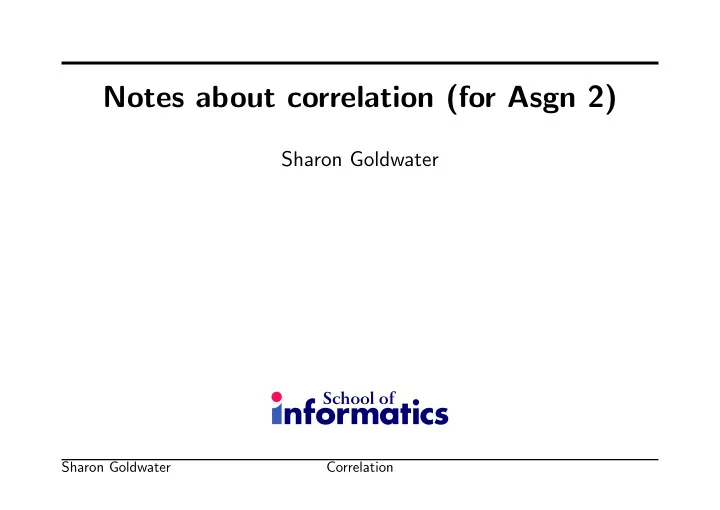

Notes about correlation (for Asgn 2) Sharon Goldwater Sharon Goldwater Correlation
Overview of assignment Exploration of distributional similarity. • Work with data extracted from Twitter (co-occurrence counts) • Compare different ways to contruct context vectors and compute similarities • Analyze and discuss differences between approaches, qualitatively and quantitatively. Work through the lab before you start the assignment! Sharon Goldwater Correlation 1
Qualitative and quantitative analysis Assignment asks you to do some of each. • Examples of qualitative analysis: – Using visualization to illustrate/discuss examples or trends – Discussing one or a few examples in more detail, by looking at our dataset and/or other Tweets (e.g., use the Twitter search page). • Examples of quantitative analysis: – Often: numerical comparison to a gold standard of accuracy – Here: consider other options, such as correlating similarity measures against word frequency. Sharon Goldwater Correlation 2
One kind of quantitative analysis • Assignment spec suggests you may want to consider correlation between similarity measures and word frequency. • Why? – A good similarity measure should measure (only) similarity. – So presumably not be correlated with frequency. – Unless more frequent words really are more similar to each other! (Would need to test with humans... let’s assume not) Sharon Goldwater Correlation 3
What is correlation? • Intuitively: two random variables X and Y are correlated if, when the value of X increases, the value of Y also tends to increase (positive correlation) or decrease (negative correlation). • Often, X and Y are different measurements for each data point. – A person’s height X and weight Y – A word’s frequency X and length Y • Two standard ways to measure correlation: – Spearman (rank) correlation: roughly as above. – Pearson (linear) correlation: more specific. Sharon Goldwater Correlation 4
Pearson correlation • Mathematically: the covariance of X and Y , normalized by the product of their individual standard deviations. • Intuitively: if I plot X against Y , how close to a perfect linear relationship do I see? – Does not measure the slope of the line, just whether there is one. (Compare rows 1 and 2, next page.) – Does not tell us if there’s some other non-linear relationship between X and Y . (See row 3, next page.) • For data samples, the Pearson correlation coefficient is usually denoted r . Sharon Goldwater Correlation 5
Pearson correlation Examples datasets with Pearson r values shown: Image source: https://commons.wikimedia.org/wiki/File:Correlation_examples.png Sharon Goldwater Correlation 6
Spearman rank correlation • Mathematically: compute the Pearson correlation between the rank ordering of X and Y values. • Intuitively: how close to a perfectly monotonic relationship do X and Y have? (i.e., when X increases, Y increases) • For data samples, the Spearman rank correlation coefficient is usually denoted ρ or r s . Sharon Goldwater Correlation 7
Spearman correlation Data with perfect rank correlation, but not perfectly linear: Image by Skbkekas (CC-BY-SA 3.0) https://en.wikipedia.org/wiki/Spearman\%27s_rank_correlation_coefficient Sharon Goldwater Correlation 8
Which one to use? • If correlation is roughly linear, Pearson will normally yield stronger results (larger absolute values) – If hypothesis testing against the possibility of no correlation, likely to have higher significance level than Spearman. – But if using large samples from corpora, often nearly any result is clearly “non-zero”. We may care more about the actual degree of correlation. • If correlation is non-linear, or nothing is known, use Spearman. Sharon Goldwater Correlation 9
But usually we do know something Best to look at the data first! For example, word freq vs length: Seems to follow a pattern, but not strongly linear. Indeed, • Spearman: ρ = − 0 . 18 • Pearson: r = − 0 . 10 (Note: I “jittered” the data so those with same (x,y) are not right on top of each other.) Sharon Goldwater Correlation 10
Log frequency Of course, using log frequencies is often more sensible: We now have • Spearman: ρ = − 0 . 18 • Pearson: r = − 0 . 21 Notice that is not ρ affected by rescaling the data. r is higher, but still only a weak linear correlation. Sharon Goldwater Correlation 11
So, which one to use? • So, Pearson can still work if there is an obvious tranformation to make the correlation roughly linear. • But if in doubt, usually fine to use Spearman. • As with all statistics, many subtleties if using for really careful analysis (see statistics course or online tutorials), but what I’ve said is probably enough for exploratory studies (i.e., your assignment). Sharon Goldwater Correlation 12
Recommend
More recommend